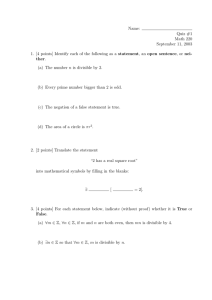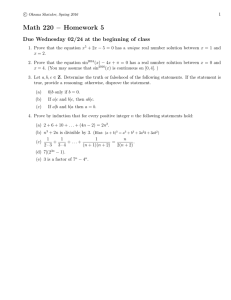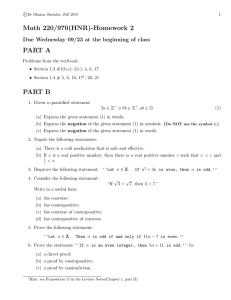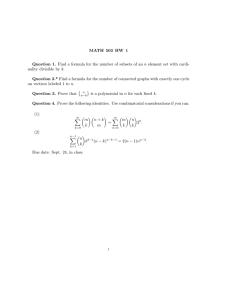Mathematics 220 Workshop 1
advertisement
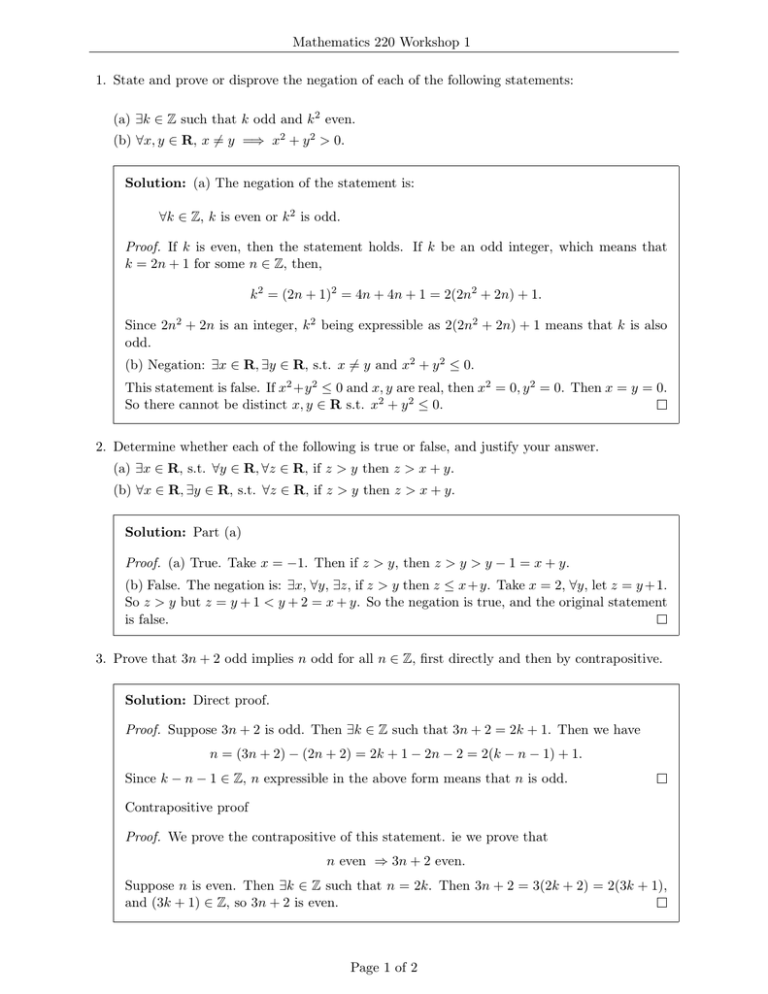
Mathematics 220 Workshop 1
1. State and prove or disprove the negation of each of the following statements:
(a) ∃k ∈ Z such that k odd and k 2 even.
(b) ∀x, y ∈ R, x 6= y =⇒ x2 + y 2 > 0.
Solution: (a) The negation of the statement is:
∀k ∈ Z, k is even or k 2 is odd.
Proof. If k is even, then the statement holds. If k be an odd integer, which means that
k = 2n + 1 for some n ∈ Z, then,
k 2 = (2n + 1)2 = 4n + 4n + 1 = 2(2n2 + 2n) + 1.
Since 2n2 + 2n is an integer, k 2 being expressible as 2(2n2 + 2n) + 1 means that k is also
odd.
(b) Negation: ∃x ∈ R, ∃y ∈ R, s.t. x 6= y and x2 + y 2 ≤ 0.
This statement is false. If x2 +y 2 ≤ 0 and x, y are real, then x2 = 0, y 2 = 0. Then x = y = 0.
So there cannot be distinct x, y ∈ R s.t. x2 + y 2 ≤ 0.
2. Determine whether each of the following is true or false, and justify your answer.
(a) ∃x ∈ R, s.t. ∀y ∈ R, ∀z ∈ R, if z > y then z > x + y.
(b) ∀x ∈ R, ∃y ∈ R, s.t. ∀z ∈ R, if z > y then z > x + y.
Solution: Part (a)
Proof. (a) True. Take x = −1. Then if z > y, then z > y > y − 1 = x + y.
(b) False. The negation is: ∃x, ∀y, ∃z, if z > y then z ≤ x +y. Take x = 2, ∀y, let z = y + 1.
So z > y but z = y + 1 < y + 2 = x + y. So the negation is true, and the original statement
is false.
3. Prove that 3n + 2 odd implies n odd for all n ∈ Z, first directly and then by contrapositive.
Solution: Direct proof.
Proof. Suppose 3n + 2 is odd. Then ∃k ∈ Z such that 3n + 2 = 2k + 1. Then we have
n = (3n + 2) − (2n + 2) = 2k + 1 − 2n − 2 = 2(k − n − 1) + 1.
Since k − n − 1 ∈ Z, n expressible in the above form means that n is odd.
Contrapositive proof
Proof. We prove the contrapositive of this statement. ie we prove that
n even ⇒ 3n + 2 even.
Suppose n is even. Then ∃k ∈ Z such that n = 2k. Then 3n + 2 = 3(2k + 2) = 2(3k + 1),
and (3k + 1) ∈ Z, so 3n + 2 is even.
Page 1 of 2
Mathematics 220 Workshop 1
1
, n], n ∈ N. Find
4. Let An = (− n+1
\
n∈N
Solution:
\
An = [0, 1],
n∈N
[
n∈N
An and
[
An .
n∈N
1
An = (− , ∞).
2
5. Is it true that if a natural number is divisible by 4 and by 3, then it must be divisible by
4 × 3 = 12?
Solution: It is true. If n is divisible by 4 = 22 , then the exponent of 2 in the prime
factorization of n is at least 2. Similarly, if n is divisible by 3, then the exponent of 3 in
the prime factorization of n is at least 1. Hence, n contains a factor of 22 × 3 = 12, which
means n is divisible by 12.
6. Is it true that if a natural number is divisible by 4 and by 6, then it must be divisible by
4 × 6 = 24?
Solution: It is false. Let n = 12. Then, n is divisible by 4 and 6 being n = 4(3) = 6(2),
but 12 is not divisible by 4 × 6 = 24 (being less than 24).
7. Prove or disprove each of the following for arbitrary sets A, B, and C.
(a) (A ∪ B) − C ⊆ (A − (B ∪ C)) ∪ (B − (A ∩ C))
(b) (A − (B ∪ C)) ∪ (B − (A ∩ C)) ⊆ (A ∪ B) − C.
Solution: Drawing Venn diagrams of the LHS and RHS of these statements illustrates that
(a) is true and (b) is false. (note, however, that Venn diagrams do NOT constitute a proof)
Proof of (a): Let x ∈ (A ∪ B) − C. Then x ∈ A ∪ B and x 6∈ C. There are two cases:
• Case 1: x ∈ B. Then x 6∈ A ∩ C as x 6∈ C. So x ∈ B − (A ∩ C). Then x ∈
(A − (B ∪ C)) ∪ (B − (A ∩ C)).
• Case 2: x ∈ A. If x ∈ B we are done by Case 1. If x 6∈ B, then x 6∈ B ∪ C so
x ∈ A − (B ∪ C). Thus, x ∈ (A − (B ∪ C)) ∪ (B − (A ∩ C)).
Therefore, (a) holds.
Disprove of (b): (Note: drawing a Venn diagram of each side helps to see where these two
sides differ, and so what you need for a counterexample)
Counterexample:
A = {0}, B = {0, 1, 2, 3}, C = {1, 2, 4}.
We have:
(A ∪ B) − C = {0, 3}
and
(A − (B ∪ C)) ∪ (B − (A ∩ C)) = {0, 1, 2, 3}.
Page 2 of 2
